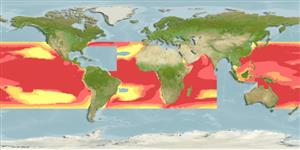Elasmobranchii (sharks and rays) >
Lamniformes (Mackerel sharks) >
Pseudocarchariidae (Crocodile sharks)
Etymology: Pseudocarcharias: pseudo-, from pseudes (Gr.), false, proposed as a subgenus of Carcharias (Odontaspididae) (See ETYFish); kamoharai: In honor of ichthyologist Toshiji Kamohara (1901-1972), Kochi University, who secured type at a fish market and presented it to Matsubara (See ETYFish).
Eponymy: Dr Toshiji Kamohara (1901–1972) was an ichthyologist who graduated from Tokyo Imperial University (1926). [...] (Ref. 128868), visit book page.
Environment: milieu / climate zone / depth range / distribution range
Ecology
Marine; pelagic-oceanic; oceanodromous (Ref. 51243); depth range 0 - 590 m (Ref. 6871), usually 0 - 200 m (Ref. 54740). Subtropical; 40°N - 40°S, 180°W - 180°E
Tropical and subtropical waters of all oceans.
Length at first maturity / Size / Weight / Age
Maturity: Lm 91.6, range 89 - ? cm
Max length : 110 cm TL male/unsexed; (Ref. 43278); 122.0 cm TL (female); common length : 100.0 cm TL male/unsexed; (Ref. 13569); max. published weight: 5.9 kg (Ref. 130455)
Dorsal spines (total): 0; Anal spines: 0. A medium-sized spindle-shaped shark with very large eyes lacking a nictitating membrane, long gill slits extending onto dorsal surface of head, lanceolate teeth, weak keel and precaudal pits on caudal peduncle (Ref. 6871, 43278). Small and low dorsal fins, with second dorsal fin less than half the size of the first but larger than the anal fin (Ref. 6871). Pectoral fin broad and rounded (Ref. 6871). Light or dark grey above, paler below, fins white-edged, sometimes with small white spots on body and a white blotch between mouth and gill slits (Ref. 13569).
An oceanic species usually found offshore and far from land but sometimes occurring inshore (Ref. 9993, 43278, 58302). Epi- and mesopelagic, with occasional near-bottom occurrences (Ref. 43278, 58302). Although considered not dangerous to people, its powerful jaws, jaw muscles and teeth invite respect. Flesh not appreciated and therefore the catch is usually discarded (Ref. 247); utilized for its large, squalene-rich liver (Ref. 9993). Feeds on small pelagic bony fishes, squids and shrimps (Ref. 5578). Ovoviviparous, embryos feeding on yolk sac and other ova produced by the mother (Ref. 50449). With 4 young in a litter, born at 40 to 43 cm TL (Ref. 12288). Maximum length for female given in Romanove et.al 1994 (Ref. 44781). Common bycatch of tuna longline fisheries, and occasionally tuna gillnet fisheries (Ref.58048).
Exhibit ovoviparity (aplacental viviparity), with embryos feeding on other ova produced by the mother (oophagy) after the yolk sac is absorbed (Ref. 50449). With 4 young in a litter, born at 40-43 cm (Ref. 11228).
Compagno, L.J.V., 1984. FAO Species Catalogue. Vol. 4. Sharks of the world. An annotated and illustrated catalogue of shark species known to date. Part 1 - Hexanchiformes to Lamniformes. FAO Fish. Synop. 125(4/1):1-249. Rome, FAO. (Ref. 247)
IUCN Red List Status (Ref. 130435: Version 2024-2)
Threat to humans
Harmless
Human uses
Fisheries: minor commercial
Tools
Special reports
Download XML
Internet sources
Estimates based on models
Preferred temperature (Ref.
123201): 16.3 - 28.2, mean 24.9 °C (based on 3402 cells).
Phylogenetic diversity index (Ref.
82804): PD
50 = 1.5000 [Uniqueness, from 0.5 = low to 2.0 = high].
Bayesian length-weight: a=0.00389 (0.00180 - 0.00842), b=3.12 (2.94 - 3.30), in cm total length, based on all LWR estimates for this body shape (Ref.
93245).
Trophic level (Ref.
69278): 4.5 ±0.58 se; based on food items.
Generation time: 8.0 ( na - na) years. Estimated as median ln(3)/K based on 1
growth studies.
Resilience (Ref.
120179): Very Low, minimum population doubling time more than 14 years (tm=5.1; K=0.14; tmax=13; Fec=4).
Fishing Vulnerability (Ref.
59153): High to very high vulnerability (66 of 100).
